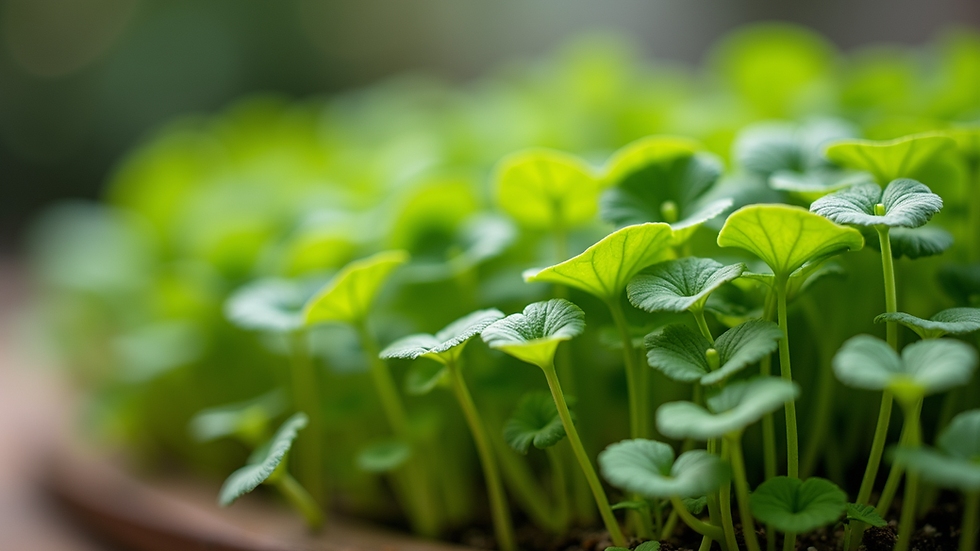The Hidden Gems of Rare Microgreens: Unveiling the Culinary Wonders
- Mudra Reads
- Mar 8
- 4 min read
Microgreens have carved a niche for themselves in the culinary world, standing out for their vibrant flavors and nutritional benefits. However, within this small segment of the plant world lies a treasure trove of rare microgreen varieties that are waiting to be discovered. As chefs and food lovers seek unique ingredients, these hidden gems offer not just culinary innovation, but also health benefits. This post will explore the world of rare microgreens, showing how they can enhance dishes while promoting sustainability and biodiversity.
Understanding Microgreens
Microgreens are young, edible plants harvested just after the first true leaves have developed. Despite their small size, they pack a punch in flavor, nutrients, and color. Common varieties like arugula, basil, and radish are often found in grocery stores, but rare microgreens provide unique tastes and nutritional profiles that can elevate any dish.
These tiny powerhouses are much more than a trend. They are a sustainable choice for chefs looking to incorporate locally-sourced produce into their menus. With the rise of farmers markets and urban farms specializing in rare varieties, microgreens represent an exciting frontier for culinary creativity.
The Flavor Profiles of Rare Microgreens
Rare microgreens can deliver exceptional flavors that are sometimes overlooked. Here are a few standout types to consider:
Nasturtium Microgreens
These microgreens have a peppery flavor reminiscent of arugula. They’re not just colorful; nasturtiums are also edible flowers. Adding them to salads or sandwiches not only enhances presentation but also contributes to overall immune health. A 100-gram serving can provide about 66% of the recommended daily intake of Vitamin C.
Cress Microgreens
Often overshadowed by their common counterparts, cress microgreens offer a robust, mustard-like flavor. Watercress, in particular, adds a refreshing zest to dishes. They thrive in moist environments, making them suitable for indoor gardening. A study showed that watercress microgreens contain up to 40% more nutrients than mature watercress.
Amaranth Microgreens
With deep red and green hues, amaranth microgreens bring a mildly earthy flavor to the table. They can effortlessly elevate salads or serve as a colorful topping in soups, not just for appearance, but also nutrition. They are high in calcium and iron, both of which are essential for maintaining strong bones and blood circulation.
Red Russian Kale Microgreens
Unlike standard kale, Red Russian varieties have a sweeter, milder flavor, along with delicate purple hues. They can enhance smoothies or serve as a visually appealing garnish for savory dishes. These microgreens can provide nearly 25% of your daily Vitamin K requirement in just one cup.
Nutritional Benefits of Rare Microgreens
Rare microgreens are packed with nutrients, often outperforming their mature plant counterparts.
Antioxidant-Rich
Microgreens like sunflower and pea shoots are incredibly rich in antioxidants. Antioxidants fight oxidative stress in your body and can potentially reduce the risk of chronic diseases. For example, sunflower microgreens can contain up to 35 times more nutrients than mature sunflowers, particularly Vitamins C and E, which play crucial roles in boosting the immune system.
Nutrient Density
Many rare microgreens provide essential nutrients such as vitamins A, C, and K, along with vital minerals like calcium, magnesium, and iron. Incorporating a variety of these into your meals is an easy way to ensure a balanced intake of nutrients. Research suggests that just 1 ounce of microgreens can provide a staggering eight times the nutrient density of ordinary vegetables.
Promote Digestive Health
Microgreens like broccoli and mustard greens are known for their fiber content, promoting digestive health. By incorporating them into your meals, you can improve digestion and enjoy a satisfying texture, which is particularly appealing for those with digestive concerns.
Culinary Applications of Rare Microgreens
The culinary possibilities with rare microgreens are exciting. Here are some ideas for creatively using these gems in your meals:
Salads
Enhance your salads by adding a variety of rare microgreens. Experiment with combinations like amaranth, nasturtium, and cress to create vibrant flavor profiles that can impress your guests.
Garnishes
Use rare microgreens as a garnish for soups and main dishes. Their vibrant colors and distinct flavors can transform an average dish into something extraordinary. For instance, a sprinkle of Red Russian kale microgreens can add both taste and presentation to any savory plate.
Juices and Smoothies
Want an energy boost? Blend microgreens like sunflower or broccoli into your morning smoothie. They add a powerful nutritional punch without overpowering other flavors, making them an ideal choice for health-conscious individuals.
Pestos and Sauces
Combine rare microgreens into pestos or sauces for a unique twist on familiar recipes. For example, replacing traditional basil with nasturtium microgreens in pesto will lend an herbaceous depth to your dishes.

Sustainability and Biodiversity
Integrating rare microgreens into our diets not only enhances our culinary experiences but also supports sustainability. By choosing these lesser-known varieties, you can help smaller farms thrive and encourage the cultivation of diverse plant species.
Additionally, many rare microgreens are easy to grow at home, even in small spaces. They require minimal resources and have a short growth cycle, allowing for quick harvests. This promotes sustainable food practices, benefiting both the environment and your kitchen.
Embrace the Hidden Gems
Exploring rare microgreens opens up a world filled with culinary possibilities. These little gems not only enhance your dishes with bold flavors and vibrant visuals but also significantly boost nutritional value. For chefs and food enthusiasts alike, they inspire innovation in the kitchen and contribute to a more sustainable food system.
As the culinary landscape evolves, embracing the distinctive tastes and benefits of rare microgreens is a delicious step toward a healthier planet. Whether you’re adding them to salads, dishes, or smoothies, they will certainly bring flavor and creativity to your culinary experiences. So, dive into the variety of rare microgreens available and start your tasty adventure today!



Comments